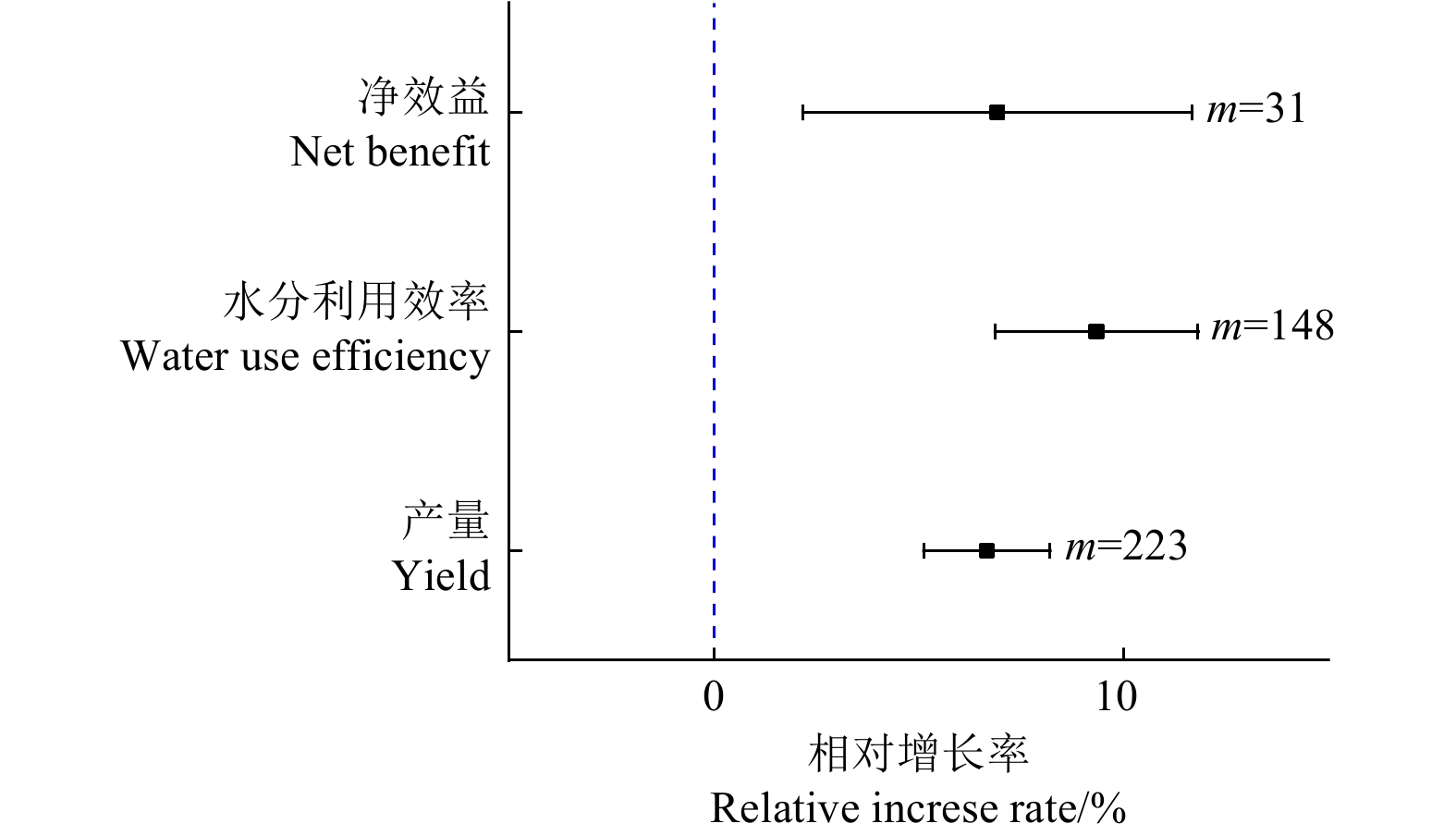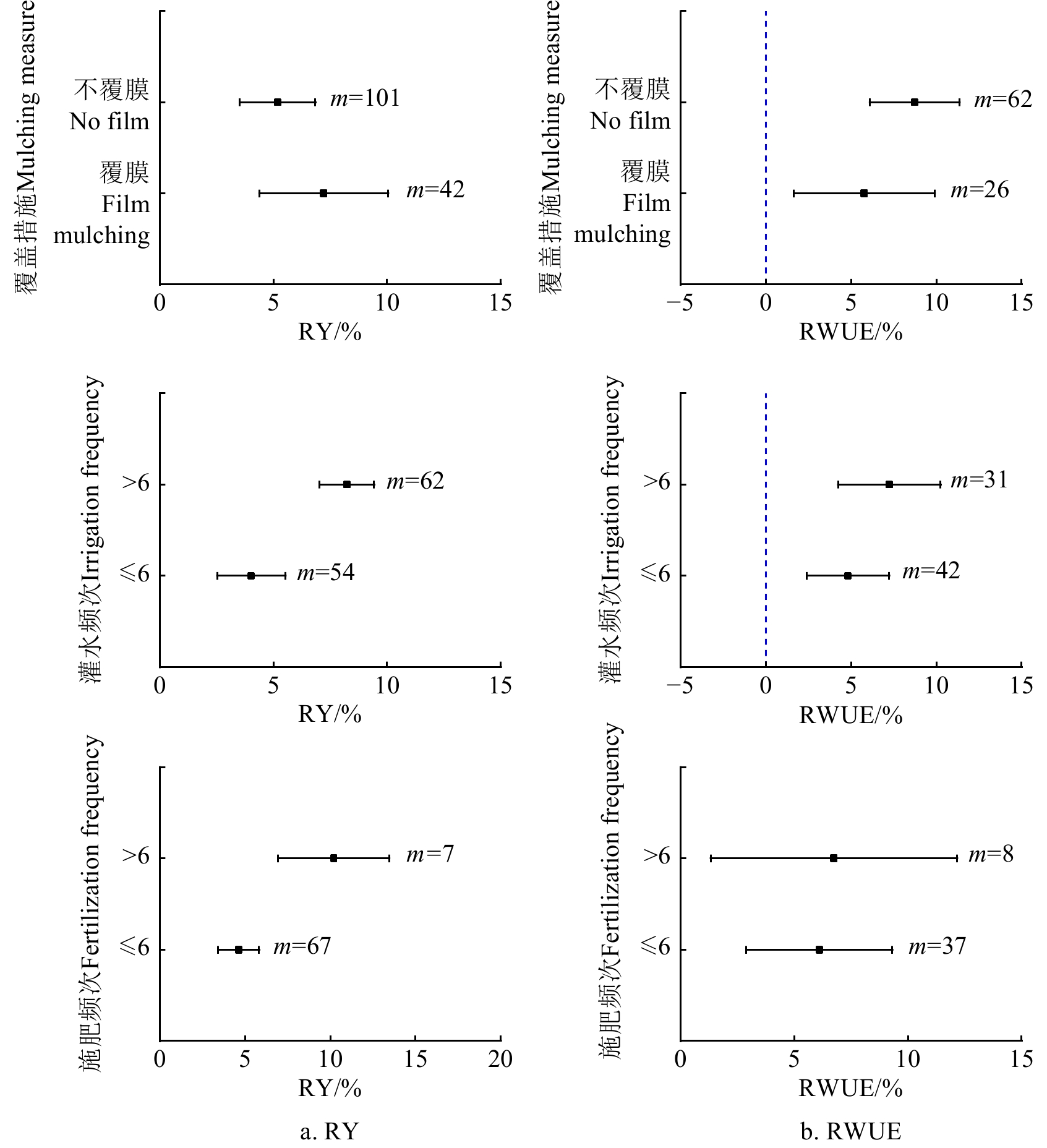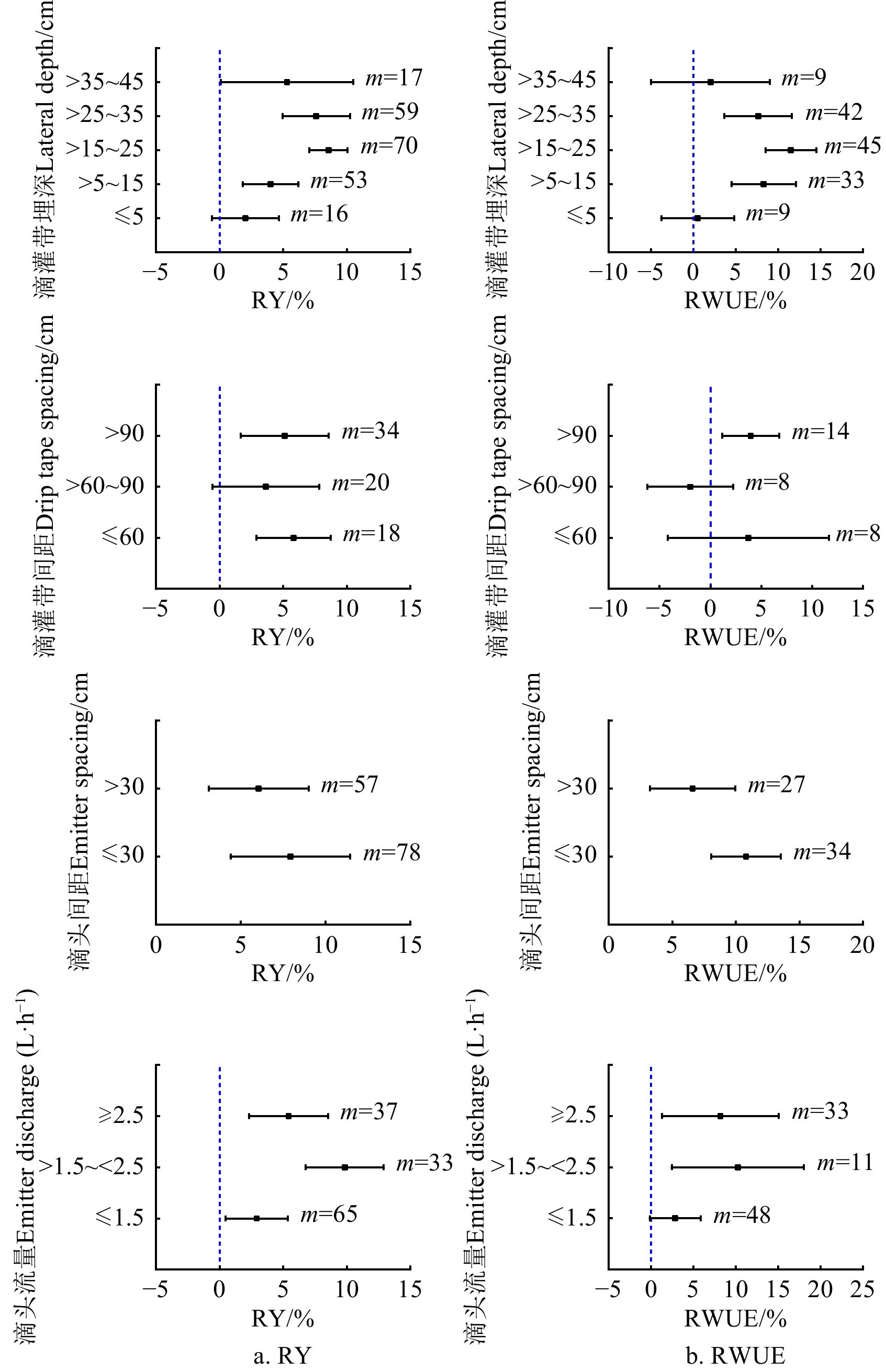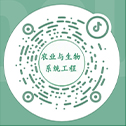Meta-analysis of water-saving and yield-increasing effects of different drip irrigation methods in Northern China
-
摘要:
为了探明中国北方地区地下滴灌(subsurface drip irrigation,SSDI)与地表滴灌(surface drip irrigation,SDI)节水增产效应的差异,该研究以SDI作为对照,采用Meta分析定量分析了不同条件下SSDI对作物产量和水分利用效率的影响。结果表明,与SDI相比,SSDI可使作物总体增产6.66%(P<0.05),水分利用效率提高9.34%(P<0.05),净效益增加6.94%(P<0.05);SSDI在西北和华北地区均能提高作物产量和水分利用效率;当年均降雨量不大于400 mm时,SSDI能显著提高作物产量;当土壤容重大于1.5 g/cm3,灌水施肥频率大于6次,滴灌带埋深为>15~25 cm,滴头流量介于>1.5~<2.5 L/h时,更有利于发挥SSDI优势,节水增产效果显著。研究可为中国北方地区SSDI的推广应用提供理论参考。
Abstract:This study was to assess the water-saving and yield-increasing differences between subsurface drip irrigation (SSDI) and surface drip irrigation (SDI) under various regional, crops, climatic, soil, field management, and drip irrigation technical factors. The data for this study were collected from literature published before November 4, 2023. The selection criteria included: 1) experiments conducted in fields in northern China; 2) data collection limited to field experiments only; 3) experiments involving both subsurface drip irrigation and surface drip irrigation treatments, with all other field trial conditions strictly consistent; 4) the article must provide at least paired data on yield, water use efficiency, or economic benefits (net benefits), as well as sample size and standard deviation. A total of 223 sets of yield data, 148 sets of water use efficiency data, and 31 sets of economic benefit (net benefit) data were obtained. The results showed that compared to SDI, SSDI could increase crop yield by 6.66% overall, improve water use efficiency by 9.34% and increase net benefits by 6.94%. When the average annual temperature was ≥12 ℃and <12 ℃, SSDI could significantly increase crop yield by 11.05% and 5.69%, respectively, and significantly improve water use efficiency by 8.18% and 5.24%, respectively, but the inter-group differences were not significant. Compared to SDI, when the annual precipitation was ≤200 mm and 200-400 mm, SSDI could significantly increase crop yield by 7.11% and 6.39%, respectively, and significantly improve water use efficiency by 7.29% and 3.89%, respectively. Compared to SDI, SSDI could significantly increase crop yield by 7.02% and 5.04% in the northwest and north China regions, respectively, and significantly improve water use efficiency by 8.57% and 10.46%, respectively, while the water-saving and yield-increasing effects were not significant in the northeast region. Compared to SDI, SSDI could significantly increase the yield of vegetables, and food crops by 9.7% and 5.14%, respectively, and significantly improve water use efficiency by 14.04% and 4.9%, respectively, but the water-saving effect on fruit crops was not significant. Compared to SDI, when the soil bulk density was ≥1.5 g/cm3 and <1.5 g/cm3, SSDI could significantly increase crop yield by 6.82% and 3.12%, respectively, and significantly improve water use efficiency by 9.44% and 3.48%, respectively. Compared to SDI, SSDI performed better under clay and sand soil conditions, significantly increasing crop yield by 10.92% and 8.31%, respectively, and significantly improving water use efficiency by 8.95% and 5.25%. Compared to SDI, SSDI with and without mulching could significantly increase crop yield by 7.21% and 5.18%, respectively, and significantly improve water use efficiency by 5.77% and 8.72%, respectively, but the difference between the two mulching measures was not significant. The higher the irrigation and fertilization frequency, the better the water-saving and yield-increasing effect of SSDI compared to SDI. When the depth of buried pipes was >15-25 cm, and the emitter discharge of drip pipe was between >1.5-<2.5 L/h, it was more conducive to realizing the advantages of SSDI, and the water-saving and yield-increasing effect was significant. In northern China, subsurface drip irrigation has a significant water-saving and yield-increasing effect compared to surface drip irrigation, especially in arid and low rainfall climate conditions. This study provided a theoretical basis for the promotion and application of subsurface drip irrigation in northern China.
-
Keywords:
- irrigation /
- crops /
- precipation /
- subsurface drip irrigation /
- increasing yield /
- saving water /
- economic benefit /
- Meta analysis
-
0. 引 言
水资源短缺是一个全球性问题。特别是在降水不足的中国北方地区,水资源短缺一直是限制该地区农业生产的重要因素。随着全球气候变暖,未来该地区的降水量可能持续减少,水资源短缺问题将进一步加剧[1]。同时,水资源短缺导致地下水超采严重[2],进而带来了一系列严重的生态环境问题,如地面沉降、海水入侵和生态系统恶化等[3]。近年来,随着城镇化加速和经济高速增长,农业耕地总量也在不断减少[4]。水资源短缺和耕地资源流失给中国农业生产和粮食安全带来了巨大的挑战,因此,采取适宜的农业措施,提高作物产量和水资源利用效率,对于保障粮食安全和区域农业可持续发展至关重要。
滴灌因其节水、节肥和省工等优势被广泛使用于作物生产实践中[5]。与地表滴灌相比,地下滴灌通过直接向作物根部供应水肥,可以最大限度地减少水肥的蒸发及渗漏损失,同时使得土壤表层相对干燥,减少病虫害的孳生和杂草生长[6-7]。因此地下滴灌在节水节肥和优化作物生长环境等方面都比地表滴灌具有更加明显的优势。近年来,地下滴灌技术已经在全球范围内推广和应用。据统计,2003—2018年,美国地下滴灌面积从占地表滴灌面积的28.96%增长为37.96%,15 a间地下滴灌面积增长了140.70%,而地表滴灌面积只增长了88.64%[8]。尽管地下滴灌较地表滴灌具有诸多优势,但由于中国地下滴灌技术起步较晚,地下滴灌初期投资成本高等原因,人们往往更倾向于使用地表滴灌[9]。同时由于存在气候条件、土壤性质、作物类型和田间管理措施等差异,导致地下滴灌在不同条件下的节水增产效应并不相同。与地表滴灌相比,地下滴灌是否更加适合中国北方地区的生产实践以及具有更加明显的节水增产效果,目前还没有取得统一的认识。一般认为地下滴灌较地表滴灌具有显著的节水增产效果[10-11],但也有研究表明地下滴灌较地表滴灌并不能显著提高作物产量和水分利用效率[12]。如陕西番茄滴灌试验表明,与地表滴灌相比,地下滴灌20 cm埋深显著促进光合作用和根系生长,产量和水分利用效率分别显著提高22.35%和35.91%[13]。河北冬小麦滴灌试验表明,与地表滴灌相比,地下滴灌通过提高土壤水分均匀性并减少无效蒸发,可以增产3.54%[14]。而宁夏中卫地区枸杞微灌试验表明,地表滴灌处理下枸杞产量比地下滴灌处理高27.18[15]。吉林省连续2 a玉米试验也表明,与地表滴灌相比,地下滴灌在砂质土和黏性土中的节水增产效果均未表现出显著差异[16]。综上,分析不同条件下滴灌方式对作物节水增产的影响具有重要意义,目前仍缺乏对中国北方地下滴灌节水增产效应的定量分析。
Meta分析是一种定量的统计学方法,通过整合分析多个具有相同或类似研究目的的独立研究,从而获得更加全面的结论。为了进一步确定不同条件下地下滴灌较地表滴灌节水增产差异,本研究采用Meta分析方法,综合分析了区域、气候条件、作物类型、土壤质地和特性、农田管理措施、滴灌技术要素下不同滴灌方式对中国北方地区作物产量和水分利用效率的影响,以期为地下滴灌在中国北方地区作物生产以及推广应用提供参考依据。
1. 材料与方法
1.1 数据检索策略和筛选条件
在中国知网、ScienceDirect和web of science文献数据库检索“地下滴灌(subsurface drip irrigation)、微灌(micro-irrigation)、滴灌方式(drip irrigation pattern)”等关键词,收集了2023年11月4日之前公开发表的文献,并对检索的文献进行了筛选,筛选标准如下:1)试验区域位于中国北方田间(不包括盆栽和防雨试验);2)数据收集仅限于实地试验(不包括数值模拟);3)试验处理需同时包含地下滴灌和地表滴灌,且其他田间试验条件严格一致。地表滴灌指在地表铺设主要供水管道,灌溉水从滴灌带上预制的滴头滴出,向作物供水。本研究中膜下滴灌也被纳入到地表滴灌范围;4)文中至少提供产量、水分利用效率或经济效益(净效益)配对数据,以及样本数和标准差。基于以上筛选标准,确定了84篇文献(17篇英文,67篇中文),共计223组产量、148组水分利用效率和31组经济效益(净效益)数据。当产量和水分利用效率以图片形式呈现在文中时,采用GetData软件提取数据。对符合标准的文献提取气候因素、作物类型、土壤质地和特性、灌溉施肥频率、毛管埋深和间距、滴头流量和间距进行亚组分析。
1.2 数据收集与分类
本文收集的数据主要来源于中国北方地区(表1)。将获取的数据进行分类统计(表2),分类标准如下:区域(华北、西北、东北);作物类型包括蔬菜(番茄、黄瓜、辣椒、茄子、大白菜)、粮食作物(小麦、玉米、土豆)、果树(梨、枣、苹果);气候条件(年均降雨量、年均气温);土壤条件(土壤容重、土壤质地);农田管理措施(灌水频次、施肥频次、覆盖措施);滴灌技术参数(滴灌带埋深、滴灌带间距、滴头流量、滴头间距)。
表 1 中国北方农田区域划分及试验地点Table 1. Region division and experiments sites of farmland in Northern China区域
Region试验分布地
Location for experiments年均气温
Annual average temperature
(AAAT)/℃年均降雨量
Annual average
precipitation (AAP)/mm收集文献数量
Number of articles
collected东北Northeast 吉林、辽宁、内蒙古东北部 -0.5~11 300~1 000 7 华北North 河北、北京、山东、河南 8~15 600~800 25 西北Northwest 陕西、山西、宁夏、内蒙古、甘肃、新疆、青海 1~14.9 50~650 52 表 2 数据分类Table 2. Date classification一级因子
First-order factor二级因子
Secondary factor分组Clusters 1 2 3 4 5 气候条件
Climatic conditionAAAT/mm >400 >200~400 ≤200 - AAP/℃ ≥12 <12 - - 土壤因素
Soil factor容重/(g·cm−3) ≥1.5 <1.5 - 质地 砂土 壤土 黏土 - 农田管理措施
Field management灌水频次 >6 ≤6 - 施肥频次 >6 ≤6 - 覆盖措施 覆膜 不覆膜 - 滴灌技术参数
Technique parameters of drip irrigation滴灌带埋深/cm ≤5 >5~15 >15~25 >25~35 >35~45 滴灌带间距/cm >90 >60~90 ≤60 - 滴头流量/(L·h−1) ≥2.5 >1.5~<2.5 ≤1.5 - 滴头间距/cm >30 ≤30 - - 区域Region 西北 华北 东北 - 作物类型Crop type 蔬菜作物 粮食作物 果树 1.3 数据分析
1.3.1 标准差计算
当文中提供产量和水分利用效率的标准差(SD)时,直接使用该值;若文中无标准差,但提供样本重复次数和标准误差(SE),则通过SD=SE⋅√N计算获得;若文中即无标准差也无标准误差时,标准误差假定为平均值的1/10[17]。
1.3.2 效应值计算与整合
利用各研究中地下滴灌处理(试验组)和地表滴灌处理(对照组)的平均产量、标准差及重复数计算效应值[18]。
ln(R)=ln(ˉXBˉXC)=ln(ˉXB)−ln(ˉXC) (1) 式中R为响应比;ln(R)为效应值;ˉXB代表地下滴灌处理下作物产量(kg/hm2)或水分利用效率(kg/m3);ˉXC地表滴灌处理下作物产量(kg/hm2)和水分利用效率(kg/m3)。
为了更加直观地反映地下滴灌对作物产量和水分利用效率的影响,本文将ln(R)转化为产量和水分利用效率增长率Z[19]:
Z=(exp(lnR)−1)×100% (2) 若Z的95%置信区间全为正值,代表地下滴灌较地表滴灌会显著提高作物产量和水分利用效率;若全部为负值,代表地下滴灌会显著降低作物产量和水分利用效率;若包含0,则表示地下滴灌对作物产量和水分利用效率无显著影响。
1.3.3 异质性检验与发表偏倚检验
采用I2统计量进行异质性检验,检验值Q计算式为[20]
Q=n∑i=1wi(E2si−_E)2 (3) I2=[Q−(n−1)]/Q (4) 式中wi为第i组数据权重;n为效应量个数;Esi为第i组数据效应量;ˉE为所有数据效应量平均值。当异质性检验结果I2大于50%采用随机效应模型进行计算,小于50%时采用固定效应模型。
采用罗森塔尔失安全系数法进行发表偏倚检验,当N>5m+10(N为失安全系数;m为样本量)时,认为无发表偏倚,反之则存在发表偏倚。
1.4 数据处理
使用Excel 2016收集与处理数据,MetaWin 3.0软件进行Meta分析、异质性检验和发表偏倚检验,Origin 2018绘制森林图。
2. 结果与分析
2.1 地下滴灌节水增产综合效应量
分别对产量、水分利用效率和净效益进行效应量计算(图1),结果表明,与SDI相比,SSDI可使作物总体增产6.66%(P<0.05),水分利用效率提高9.34%(P<0.05),经济净效益提高6.94%(P<0.05)。异质性检验结果表明,产量、水分利用效率和净效益I2统计量分别为50.6%、53.7%和62.5%,因此均采用随机效应模型。发表偏倚检验结果表明,产量、水分利用效率和经济净效益罗森塔尔失安全系数分别为4 278、2 226和524,均大于5m+10,故不存在发表偏倚。
![]() 图 1 地下滴灌较地表滴灌节水增产效果注:m代表样本量,误差线表示95%置信区间,若误差线与虚线相交,表示处理和对照之间差异不显著(P>0.05),下同。Figure 1. Effects of subsurface drip irrigation in saving water and increasing yield compared to surface drip irrigationNote: m represents the sample size and the error line represents the 95% confidence interval. If the error line intersects with the dotted line, it means that the difference between the treatment and the control is not significant (P>0.05),Same below.
图 1 地下滴灌较地表滴灌节水增产效果注:m代表样本量,误差线表示95%置信区间,若误差线与虚线相交,表示处理和对照之间差异不显著(P>0.05),下同。Figure 1. Effects of subsurface drip irrigation in saving water and increasing yield compared to surface drip irrigationNote: m represents the sample size and the error line represents the 95% confidence interval. If the error line intersects with the dotted line, it means that the difference between the treatment and the control is not significant (P>0.05),Same below.2.2 不同区域、气候下地下滴灌节水增产效应分析
不同气候条件下,SSDI较SDI节水增产效果不同(图2a和图2b)。
由图2可知,与SDI相比,年均气温≥12和<12℃时,SSDI可使作物显著增产11.05%和5.69%(P<0.05),水分利用效率显著提高8.18%和5.24%(P<0.05),但组间差异并不显著。与SDI相比,年均降雨量≤200和>200~400 mm时,SSDI可使作物显著增产7.11%和6.39%(P<0.05),水分利用效率显著提升7.29%和3.89%(P<0.05);年均降雨量为>400 mm时,SSDI较SDI的节水增产效果并不显著(P>0.05)。与SDI相比,SSDI可使西北和华北地区作物显著增产7.02%和5.04%(P<0.05),水分利用效率显著提高8.57%和10.46%(P<0.05),而东北地区节水增产效果均不显著(P>0.05),不同区域之间SSDI节水增产效果并未达到显著水平。总体而言,与SDI相比,SSDI可以提高西北和华北地区作物产量和水分利用效率,适合降水量小于等于400 mm的区域。
2.3 不同作物和土壤条件下地下滴灌节水增产效应分析
滴灌方式对不同作物产量和水分利用效率的影响也存在一定差异(图3a和图3b)。
由图3可知,与SDI相比,SSDI可使蔬菜和粮食作物显著增产9.70%和5.14%(P<0.05),水分利用效率显著提高14.04%和4.90%(P<0.05);对于果树,SSDI节水增产效果并不显著。在不同土壤条件下,SSDI节水增产效果不同。与SDI相比,土壤容重≥1.5和<1.5 g/cm3时,SSDI可使作物显著增产6.82%和3.12%,使水分利用效率显著提高9.44%和3.48%。与SDI相比,在黏土和砂土中、SSDI节水增产效果较好,可使作物产量显著增加10.92%和8.31%(P<0.05),使水分利用效率显著增加8.95%和5.25%(P<0.05);而在壤土中产量显著增加3.61%,水分利用效率显著增加2.58%(P <0.05)。
2.4 不同农田管理措施下地下滴灌节水增产效应分析
如图4所示,不同农田管理措施下,SSDI节水增产效果不同。与SDI相比,在覆膜和不覆膜时,SSDI可使作物产量显著提高7.21%和5.18%(P<0.05),使水分利用效率显著提高5.77%和8.72%(P<0.05),但两种覆盖措施之间差异不显著(P>0.05)。与SDI相比,在灌水频次>6和≤6次时,SSDI可使作物显著增产8.23%和4.02%(P<0.05);使水分利用效率显著提高7.24%和4.82%(P<0.05),但组间差异不显著。与SDI相比,在施肥频次>6和≤6次时,SSDI可使作物显著增产10.20%和4.62%(P<0.05);水分利用效率显著提高6.74%和6.10%(P<0.05),但组间差异不显著。
2.5 不同滴灌技术要素下地下滴灌节水增产效应分析
SSDI技术要素对作物产量和水分利用效率的影响如图5所示。与SDI相比,随着滴灌带埋深增大,SSDI对作物产量和水分利用效率的影响呈现出先增大后减小的趋势。滴灌带埋深为>15~25 cm时,SSDI节水增产效果最大,产量和水分利用效率显著提高了8.56%和11.50%(P<0.05),不同埋深之间差异达到了显著水平(P<0.05)。与SDI相比,SSDI在滴灌带间距≤60和>90 cm时可使作物显著增产5.80%和5.12%(P<0.05),滴灌带间距为60~90 cm时,SSDI增产效果不显著(P>0.05);滴灌带间距≤60和介于60~90 cm时,SSDI节水效果不显著,>90 cm时可提高水分利用效率4.08%,不同滴灌带间距之间产量和水分利用效率差异不显著。
由图5可知,当滴头间距≤30和>30 cm时,SSDI较SDI可使作物显著增产7.91%和6.05%(P<0.05),水分利用效率显著提高10.8%和6.6%,但不同滴头间距之间节水增产效果并不显著(P>0.05)。与SDI相比,在滴头流量≤1.5、>1.5~<2.5和≥2.5 L/h时,SSDI可使作物显著增产2.9%、9.8%和5.4%,并且三者之间差异达到极显著水平(P<0.01)。与SDI相比,在滴头流量>1.5~<2.5和≥.5 L/h时,SSDI可分别使作物水分利用效率提高10.2%和8.16%(P<0.05),但3个滴头流量之间水分利用效率差异并不显著。
3. 讨 论
3.1 不同区域、气候条件和作物类型下地下滴灌节水增产效应
本研究发现,与SDI相比,SSDI节水增产效果显著(图1)。亚组分析表明在西北和华北地区SSDI较SDI能显著提高作物产量和水分利用效率,且在不同区域节水增产效果无显著差异(图2)。针对降雨量进行亚组分析可知年均降雨量≤400 mm时,SSDI增产效果显著。因此,表明SSDI较适合中国北方地区,并不受地域影响,更适合降雨量≤400 mm的气候条件。分析原因如下:中国北方地区干旱频发且持续时间较长、气温较高导致水分蒸发大[21],尤其是西北地区气候条件最为严苛,作物生长严重依赖灌溉。另外,近年来华北地区水资源短缺导致地下水超采过度,近10年,华北地区地下水位以1.35 m/a的速度下降[22]。在此气候条件下,SSDI比SDI可以减少15%的土壤水分蒸发损失[14],保持生育期内较高土壤含水率,有利于作物生长,进而表现出更高的节水增产效果。针对不同作物类型进行亚组分析发现,SSDI对蔬菜作物节水增产效果较大,对粮食作物和果树影响较小。这可能是因为蔬菜根系分布在浅土层且吸收能力弱[23],对浅土层水分变化较为敏感,因此更容易受到水分蒸发的影响。而粮食作物和果树根系较为发达、吸收能力较强,分布相对更广更深[24-25],一定程度上弥补了灌溉方式带来的土壤水分差异,因此节水增产作用较小。基于中国北方地区水资源及气候现状,本研究认为,SSDI节水增产效果更好,比较适合中国北方地区,建议推广使用。
3.2 不同技术要素下地下滴灌节水增产效应
本研究结果表明,随着毛管埋深增大,SSDI对作物产量和水分利用效率的影响表现出先增大后减小的趋势,埋深为>15~25 cm时正效应达到最大。这可能是因为>15~25 cm埋深产生的土壤湿润体改善了作物根系分布与生长,优化了根冠比,进而促进水肥吸收,使得更多的光合产物分配到地上部分[26]。另外,>15~25 cm埋深下土壤水分蒸发很小几乎可以忽略不计[27],并且可以提高作物根系氮磷代谢,从而提高产量和水分利用效率[28]。本研究表明不同滴灌带间距之间节水增产效果差异并不显著,这与前人研究[29-30]类似。这可能是因为受气候或其他因素影响,例如前人研究表明丰水年,滴灌带间距对作物产量和水分利用效率并无显著性影响[31],而干旱年份,较窄的滴灌带间距比宽间距会更有利于提高产量和水分利用效率[32]。另外在充分灌溉条件下,滴灌带间距对作物产量和水分利用效率影响也并不显著[33]。
本研究结果表明,与SDI相比,滴头流量显著影响SSDI节水增产效果,滴头流量为1.5~2.5 L/h时节水增产效果最好。这可能是因为滴头埋在土壤一定深度,随时间增大,滴头附近土壤水分逐渐饱和,土壤水分扩散速率变慢。此时滴头周围压力增大,滴头正压出现,滴头出流速度减小[34-35],滴头流量降低了10%~50%[36-37]。研究表明,土壤压力起到了调节作用,可以提高土壤水分均匀度[38],从而提高了产量和水分利用效率。而滴头流量较小时,粗质土中水分竖向扩散较大[39],水肥深层渗漏风险增大。总体而言滴头流量为>1.5~2.5 L/h更适合SSDI。
为了更好地使用和发挥SSDI的节水增产效果,毛管埋深不宜太深,滴头流量应当适中,建议选择滴头流量为>1.5~2.5 L/h,埋深不宜大于35 cm,特别推荐的毛管埋深为>15~25 cm。
3.3 不同农田管理措施和土壤条件下地下滴灌节水增产效应
本研究结果表明,SSDI灌水施肥频次越多,增产效果越好,这与前人[40]研究结果类似,即高频灌溉显著提高作物产量。这可能是因为高频率灌水通过适时适量给作物供应水肥,可以及时满足作物各生育期水肥需求,减少水肥的挥发与淋失损失[41]。此外,盐碱化和次生盐碱化问题在中国北方广泛存在[42],西北、华北和东北地区都存在一定程度上的土壤盐碱化问题。SSDI通过向作物根系区域供应适量水分,可以将土壤中的盐分冲刷到根系区域之外,减少盐分积累对作物根系产生不利影响[43-44],因此,高频的灌水施肥制度比较适合中国北方地区作物生产实践。
本研究结果表明,当土壤容重>1.5 g/cm3和在黏土条件下,SSDI节水增产效果较好。这可能是因为不同类型土壤持水能力、水分运移和再分配状况皆不相同[45]。前人研究表明黏土水分横向运移更大,砂土水分竖向运移更大[46]。并且黏土和大容重土壤持水能力较强,可以将水肥保留在土壤中更长时间,利于作物吸收,而砂土和低容重土壤颗粒较大,渗透性较好,持水能力较差[47]。因此在砂土中,应提高灌水频率和减少灌溉水量,以减少深层渗漏和水分蒸发。综上,建议在黏土和砂土中尽可能选用SSDI,能更好地实现节水增产效果。
3.4 地表和地下滴灌经济效益
本研究经济效益分析表明,与SDI相比,SSDI可使作物总体经济效益提高6.94%(P<0.05),张浩文[48]研究结果也表明SSDI较SDI经济效益更高。虽然SSDI初始投资成本较高,但通过良好的管理和维护,其使用寿命往往能超过10 a,甚至可达20 a以上,因此其设备和管材的摊销成本比SDI更低。而且SDI每个种植季的废旧毛管回收和新毛管铺设等需要大量劳动力投入,相比之下,SSDI每年可减少176 h/hm2的劳动力[49],因此节约的劳动力成本和潜在的收益往往更大。但是SSDI在生产实践中不可避免会受到啮齿动物啃咬和农事活动的影响,导致滴灌带破损从而产生更高的维护费用,而SDI该部分的维护费用较少。因此在SSDI的生产实践中需要通过更加精细的管理去减少毛管破坏的几率,进而减少维护费用。
3.5 应用、局限和展望
根据本文研究结果,建议在中国北方地区推广地下滴灌技术,特别是在蔬菜作物中。生产实践中应提高灌水施肥频次,灌水施肥次数均大于6次;在黏土和砂土中优先采用地下滴灌;当滴灌带埋深为>15~25 cm,滴头流量为1.5~2.5 L/h时,更能发挥地下滴灌优势,节水增产效果较好。
本研究综合分析了中国北方地区SSDI较SDI节水增产效应差异。但是亚组分析中东北地区和滴灌带间距数据量不够充分,该部分分析结果有待进一步验证。由于本研究收录文献数据有限,无法针对具体作物进行详细分析。另外不同作物灌水施肥量以及生育期降雨量和气温对SSDI的节水增产效应均存在一定影响,后续研究需要考虑更多因素以及针对具体作物进行分析。
4. 结 论
本文通过收集不同滴灌方式对作物节水增产影响的文章数据,采用Meta分析方法对不同生产条件下地下滴灌(subsurface drip irrigation,SSDI)较地表滴灌(surface drip irrigation,SDI)的节水增产效应进行了研究,结论如下:
1)SSDI较SDI节水增产效果显著,可使作物总体增产6.66%,水分利用效率提高9.34%,净效益提高6.94%;在中国北方地区SSDI节水增产并不受区域影响,在西北地区和华北地区,SSDI均能提高作物产量和水分利用效率;SSDI在年均降雨量≤400 mm时更有利于作物增产。因此,建议在中国北方年均降雨量较低区域采用SSDI,以更有效地促进作物增产并节约水资源。
2)SSDI节水增产效应受土壤、农田管理措施和滴灌技术要素影响。SSDI适用于黏土和砂土;土壤容重≥1.5 g/cm3时,SSDI节水增产效果与显著高于<1.5 g/cm3;SSDI适用于高频的灌水施肥制度;与SDI相比,在毛管埋深为>15~25 cm以及滴头流量介于>1.5~<2.5 L/h时,SSDI节水增产效果较好。因此,在SSDI生产实践中,需要综合考虑土壤、农田管理措施和滴灌技术要素的影响。
-
图 1 地下滴灌较地表滴灌节水增产效果
注:m代表样本量,误差线表示95%置信区间,若误差线与虚线相交,表示处理和对照之间差异不显著(P>0.05),下同。
Figure 1. Effects of subsurface drip irrigation in saving water and increasing yield compared to surface drip irrigation
Note: m represents the sample size and the error line represents the 95% confidence interval. If the error line intersects with the dotted line, it means that the difference between the treatment and the control is not significant (P>0.05),Same below.
表 1 中国北方农田区域划分及试验地点
Table 1 Region division and experiments sites of farmland in Northern China
区域
Region试验分布地
Location for experiments年均气温
Annual average temperature
(AAAT)/℃年均降雨量
Annual average
precipitation (AAP)/mm收集文献数量
Number of articles
collected东北Northeast 吉林、辽宁、内蒙古东北部 -0.5~11 300~1 000 7 华北North 河北、北京、山东、河南 8~15 600~800 25 西北Northwest 陕西、山西、宁夏、内蒙古、甘肃、新疆、青海 1~14.9 50~650 52 表 2 数据分类
Table 2 Date classification
一级因子
First-order factor二级因子
Secondary factor分组Clusters 1 2 3 4 5 气候条件
Climatic conditionAAAT/mm >400 >200~400 ≤200 - AAP/℃ ≥12 <12 - - 土壤因素
Soil factor容重/(g·cm−3) ≥1.5 <1.5 - 质地 砂土 壤土 黏土 - 农田管理措施
Field management灌水频次 >6 ≤6 - 施肥频次 >6 ≤6 - 覆盖措施 覆膜 不覆膜 - 滴灌技术参数
Technique parameters of drip irrigation滴灌带埋深/cm ≤5 >5~15 >15~25 >25~35 >35~45 滴灌带间距/cm >90 >60~90 ≤60 - 滴头流量/(L·h−1) ≥2.5 >1.5~<2.5 ≤1.5 - 滴头间距/cm >30 ≤30 - - 区域Region 西北 华北 东北 - 作物类型Crop type 蔬菜作物 粮食作物 果树 -
[1] XIAL D, LIU D L, FENG P, et al. Future climate change impacts on grain yield and groundwater use under different cropping systems in the North China Plain[J]. Agricultural Water Management, 2021, 246: 106685. doi: 10.1016/j.agwat.2020.106685
[2] 陈浮,曾思燕,葛小平,等. 资源环境硬约束下中国耕地休耕优先区识别[J]. 农业工程学报,2021,37(22):226-235. doi: 10.11975/j.issn.1002-6819.2021.22.026 CHEN Fu, ZENG Siyan, GE Xiaoping, et al. Identifying the fallow priority areas of cultivated land under resources and environmental constraints in China[J]. Transactions of the Chinese Society of Agricultural Engineering (Transactions of the CSAE), 2021, 37(22): 226-235. (in Chinese with English abstract) doi: 10.11975/j.issn.1002-6819.2021.22.026
[3] ZHAO Y, WANG L, LI H, et al. Evaluation of groundwater overdraft governance measures in Hengshui City, China[J]. Sustainability, 2020, 12(9): 3564. doi: 10.3390/su12093564
[4] 程宪波,高根红,刘琼,等. 快速城镇化地区的耕地撂荒空间格局、影响机理与治理路径[J]. 农业工程学报,2022,38(24):218-227. doi: 10.11975/j.issn.1002-6819.2022.24.024 CHENG Xianbo, GAO Genhong, LIU Qiong, et al. Spatial pattern, causal mechanisms and governance strategies of cultivated land abandonment in rapidly urbanizing areas:[J]. Transactions of the Chinese Society of Agricultural Engineering (Transactions of the CSAE), 2022, 38(24): 218-227. (in Chinese with English abstract) doi: 10.11975/j.issn.1002-6819.2022.24.024
[5] 李鹏,曹华,詹伟,等. 滴灌节水技术应用机理及热点研究进展[J]. 节水灌溉,2024(2):62-68,75. doi: 10.12396/jsgg.2023369 LI Peng, CAO Hua, ZHAN Wei, et al. Application mechanism of drip irrigation water saving technology and hot spot research progress[J]. Water Saving Irrigation, 2024(2): 62-68,75. (in Chinese with English abstract) doi: 10.12396/jsgg.2023369
[6] WANG J W, YAO Z, HAN J, et al. Different pipe burial depths associated with subsurface drip irrigation significantly affected soil gas emissions[J]. Annals of Applied Biology, 2022, 180(2): 294-305. doi: 10.1111/aab.12736
[7] 杨开鑫,赵建涛,王旭哲,等. 不同灌溉方式及施磷对紫花苜蓿产量、品质及水磷利用效率的影响[J]. 农业工程学报,2023,39(21):130-138. doi: 10.11975/j.issn.1002-6819.202305161 YANG Kaixin, ZHAO Jiantao, WANG Xuzhe, et al. Effects of different irrigation methods and phosphorus application on alfalfayield, quality and water and phosphorus use efficiency[J]. Transactions of the Chinese Society of Agricultural Engineering(Transactions of the CSAE), 2023, 39(21): 130-138. (in Chinese with English abstract) doi: 10.11975/j.issn.1002-6819.202305161
[8] LAMM F R, COLAIZZI P D, SORENSEN R B, et al. A 2020 vision of subsurface drip irrigatino in the US[J]. TASABE, 2021, 64(4): 1319-1343. doi: 10.13031/trans.14555
[9] 康绍忠. 贯彻落实国家节水行动方案 推动农业适水发展与绿色高效节水[J]. 中国水利,2019(13):1-6. doi: 10.3969/j.issn.1000-1123.2019.13.004 KANG Shaozhong. National water conservation initiative for promoting water-adapted and green agriculture and highly-efficient water use[J]. China Water Resources, 2019(13): 1-6. (in Chinese with English abstract) doi: 10.3969/j.issn.1000-1123.2019.13.004
[10] LAMM F R. Cotton, tomato, corn, and onion production with subsurface drip irrigation: A review[J]. Transactions of the ASABE, 2016, 59(1): 263-278. doi: 10.13031/trans.59.11231
[11] 何新林,王佳鑫,龚萍,等. 南疆矮化密植高产优质香梨节水灌溉模式筛选[J]. 农业工程学报,2024,40(2):249-262. HE Xinlin, WANG Jiaxin, GONG Ping, et al. Irrigation modes screening for water saving, high yield and quality of dwarfed and densely planted fragrant pears in South Xinjiang of China[J]. Transactions of the Chinese Society of Agricultural Engineering(Transactions of the CSAE), 2024, 40(2): 249-262. (in Chinese with English abstract)
[12] 袁江杰,李光永,袁子程. 膜下滴灌和地下滴灌条件下玉米耗水、生长和产量对比[J]. 灌溉排水学报,2015,34(12):93-98. YUAN Jiangjie, LI Guangyong, YUAN Zicheng. Effects of Mulched Drip Irrigation and Subsurface Drip Irrigation on Corn Water Consumption, Growth and Yield[J]. Journal of Irrigation and Drainage, 2015, 34(12): 93-98. (in Chinese with English abstract)
[13] 王京伟,牛文全,郭丽丽,等. 适宜的毛管埋深提高温室番茄品质及产量[J]. 农业工程学报,2017,33(20):90-97. doi: 10.11975/j.issn.1002-6819.2017.20.012 WANG Jingwei, NIU Wenquan, GUO Lili, et al. Suitable buried depth of drip irrigation improving yield and quality of tomato in greenhouse[J]. Transactions of the Chinese Society of Agricultural Engineering (Transactions of the CSAE), 2017, 33(20): 90-97 . (in Chinese with English abstract) doi: 10.11975/j.issn.1002-6819.2017.20.012
[14] UMAIR M, HUSSAIN T, JIANG H, et al. Water-saving potential of subsurface drip irrigation for winter wheat[J]. Sustainability-Basel, 2019, 11(10): 1-16.
[15] 董世德,秦垦,万书勤,等. 不同微灌形式对土壤水肥分布和枸杞产量的影响[J]. 节水灌溉,2017(8):38-43. DONG Shide, QIN Keng, WAN Shuqing, et al. Effect of different micro-irrigation methods on soil moisture, nutrients distribution and the yield of Lycium barbarbum L[J]. Water Saving Irrigation, 2017(8): 38-43. (in Chinese with English abstract)
[16] WU D L, XU X, CHEN Y, et al. Effect of different drip fertigation methods on maize yield, nutrient and water productivity in two-soils in Northeast China[J]. Agricultural Water Management, 2019, 213: 200-211. doi: 10.1016/j.agwat.2018.10.018
[17] LUO Y Q, HUI D F, ZHANG D Q. Elevated CO2 stimulates net accumulations of carbon and nitrogen in land ecosystems: A Meta-analysis[J]. Ecology, 2006, 87(1): 53-63. doi: 10.1890/04-1724
[18] HEDGES L V, GUREVITCH J, CURTIS P S. The Meta-analysis of response ratios in experimental ecology[J]. Ecology, 1999, 80(4): 1150-1156. doi: 10.1890/0012-9658(1999)080[1150:TMAORR]2.0.CO;2
[19] 章力干,石心怡,王玉宝,等. 秸秆还田对中国主要粮食作物病害影响的Meta分析[J]. 农业工程学报,2022,38(21):93-100. doi: 10.11975/j.issn.1002-6819.2022.21.012 ZHANG ligan, SHI Xinyi, WANG Yubao, et al. Meta-analysis for the impacts of straw return on the diseases of major grain crops in China[J]. Transactions of the Chinese Society of Agricultural Engineering (Transactions of the CSAE), 2022, 38(21): 93-100. (in Chinese with English abstract) doi: 10.11975/j.issn.1002-6819.2022.21.012
[20] 赵政鑫,王晓云,田雅洁,等. 基于Meta分析的不同生产条件下秸秆还田对土壤氨挥发的影响[J]. 环境科学,2022,43(3):1678-1687. ZHAO Zhenxing, WANG Xiaoyun, TIAN Yajie, et al. Effects of straw returning on soil ammonia volatilization under different production conditions based on Meta-analysis[J]. Environmental Science, 2022, 43(3): 1678-1687. (in Chinese with English abstract)
[21] 胡子瑛,周俊菊,张利利,等. 中国北方气候干湿变化及干旱演变特征[J]. 生态学报,2018,38(6):1908-1919. HU Ziying, ZHOU Junju, ZHANG Lili, et al. Climate dry-wet change and drought evolution characteristics of different dry-wet areas in northern China[J]. Acta Ecologica Sinica, 2018, 38(6): 1908-1919. (in Chinese with English abstract)
[22] YANG W I, LONG D, SCANLON B R, et al. Human intervention will stabilize groundwater storage across the north china plain [J]. Water Resources Research, 2022, 58(2): e2021WR030884
[23] LESKOVAR D I, STOFFELLA P J. Vegetable seedling root systems: morphology, development, and importance[J]. HortScience, 1995, 30(6): 1153-1159. doi: 10.21273/HORTSCI.30.6.1153
[24] GAO Y, DUAN A, QIU X, et al. Distribution of roots and root length density in a maize/soybean strip intercropping system[J]. Agricultural Water Management, 2010, 98(1): 199-212. doi: 10.1016/j.agwat.2010.08.021
[25] JACKSON R B, CANADELL J, EHLERINGER J R, et al. A global analysis of root distributions for terrestrial biomes[J]. Oecologia, 1996, 108: 389-411. doi: 10.1007/BF00333714
[26] 何华,康绍忠,曹红霞. 地下滴灌埋管深度对冬小麦根冠生长及水分利用效率的影响[J]. 农业工程学报,2001(6):31-33. HE Hua, KANG Shaozhong, CAO Hongxia. Effect of lateral depth on root and seedling growth and water use efficiency of winter wheat[J]. Transactions of the Chinese Society of Agricultural Engineering (Transactions of the CSAE), 2001(6): 31-33. (in Chinese with English abstract)
[27] Al-MEFLEH N K, ABU-ZREIG M. Field evaluation of arid soils wetting pattern in subsurface drip irrigation scheme[J]. Clean-Soil Air Water, 2013, 41(7): 651-656. doi: 10.1002/clen.201100748
[28] WANG J W, NIU W Q, LI Y, et al. Subsurface drip irrigation enhances soil nitrogen and phosphorus metabolism in tomato root zones and promotes tomato growth[J]. Applied Soil Ecology, 2018, 124: 240-251. doi: 10.1016/j.apsoil.2017.11.014
[29] LI G, BAI Y L, WANG L, et al. Effects of fertilizer under different dripline spacings on summer maize in northern China[J]. Scientific Reports, 2021, 11(1): 18922, doi: 10.1038/s41598-021-98016-6
[30] WAN W L, LI L L, JING J G, et al. Narrowing row space improves productivity and profit of enlarged lateral space drip irrigated spring wheat system in Xinjiang, China[J]. Field Crops Research, 2022, 280: 108474. doi: 10.1016/j.fcr.2022.108474
[31] 要家威,齐永青,李怀辉,等. 地下滴灌量与滴灌带间距对夏玉米生长发育的影响[J]. 中国生态农业学报(中英文),2021,29(9):1502-1511. YAO Jiawei, QI Yongqing, LI Huaihui. et al. Effects of the irrigation quota and drip irrigation pipes spacing on growth and development of summer maize with subsurface drip irrigation[J]. Chinese Journal of Eco-Agriculture,2021, 29(9): 1502-1511. (in Chinese with English abstract)
[32] ARDENTI F, ABALOS D, CAPRAF, et al. Matching crop row and dripline distance in subsurface drip irrigation increases yield and mitigates N2O emissions[J]. Field Crops Research, 2022, 289: 108732. doi: 10.1016/j.fcr.2022.108732
[33] ARBAT G P, LAMM F R, AOIUT KHEIRA A A. Subsurface drip irrgation emittre spacing on soil water redistribution, corn yield, and water productivity[J]. Applied Engineering in Agriculture, 2010, 26(3): 391-399. doi: 10.13031/2013.29959
[34] 王晓愚,白丹,李占斌,等. 地下滴灌灌水器水力要素试验研究[J]. 农业工程学报,2008,24(10):6-10. doi: 10.3321/j.issn:1002-6819.2008.10.002 WANG Xiaoyu, BAI Dan, LI Zhanbing, et al. Experimental study on hydraulic characteristics of emitter under subsurface drip irrigation[J]. Transactions of the Chinese Society of Agricultural Engineering (Transactions of the CSAE), 2008, 24(10): 6-10. (in Chinese with English abstract) doi: 10.3321/j.issn:1002-6819.2008.10.002
[35] 仵峰,李王成,范永申,等. 地下滴灌灌水器出口正压试验研究[J]. 灌溉排水学报,2003(2):48-50,54. doi: 10.3969/j.issn.1672-3317.2003.02.012 WU Feng, LI Wangcheng, FAN Yongsheng, et al. Experimental study on positive pressure in area around emitter in subsurface drip irrigation[J]. Journal of Irrigation and Drainage, 2003(2): 48-50,54. (in Chinese with English abstract) doi: 10.3969/j.issn.1672-3317.2003.02.012
[36] SHANI U, XUE S, GORDINKATZ R, et al. Soil-limiting flow from subsurface emitters. 1. Pressure measurements[J]. Journal of Irrigation and Drainage Engineering, 1996, 122(5): 291-295.
[37] 仵峰,李王成,李金山,等. 地下滴灌灌水器水力性能试验研究[J]. 农业工程学报,2003,29(2):85-88. WU Feng, LI Wangcheng, LI Jinshan, et al. Hydraulic characteristics of emitter in soil of subsurface drip irrigation system[J]. Transactions of the Chinese Society of Agricultural Engineering (Transactions of the CSAE), 2003,29(2): 85-88. (in Chinese with English abstract)
[38] GIL M, RODRIGUEZ-SINOGAS L, JUANA L, et al. Emitter discharge variability of subsurface drip irrigation in uniform soils: effect on water-application uniformity[J]. Irrigation Science, 2008, 26: 451-458. doi: 10.1007/s00271-008-0116-1
[39] BAJPAI A, KAUSHAL A. Soil moisture distribution under trickle irrigation: A review[J]. Water Supply, 2020, 20(3): 761-772. doi: 10.2166/ws.2020.005
[40] COLAK B Y. Effects of irrigation frequency and level on yield and stomatal resistance of eggplance (Solanum Melongena L.) grown in open field irrigated with surface and subsurface drip methods[J]. Applied Ecology and Environmental Research, 2019, 17(6): 15585-15604.
[41] BRONSON K F, HUNSAKER D J, WILLIAMS C F, et al. Nitrogen management affects nitrous oxide emissions under varying cotton irrigation systems in the Desert Southwest, USA[J]. Journal of environmental quality, 2018, 47(1): 70-78. doi: 10.2134/jeq2017.10.0389
[42] YANG J , ZHANG S , LI Y , et al. Dynamics of saline-alkali land and its ecological regionalization in western Songnen Plain, China[J]. Chinese Geographical Science, 2010, 20(2): 159-166.
[43] ROBERTS T L, WHITE S A, WARRICK A W, et al. Tape depth and germination method influence patterns of salt accumulation with subsurface drip irrigation[J]. Agricultural Water Management, 2008, 95(6): 669-677. doi: 10.1016/j.agwat.2008.01.003
[44] ROBERTS T L, LAZAROVITCH N, WARRICK A W, et al. Modeling salt accumulation with subsurface drip irrigation using HYDRUS-2D[J]. Soil Science Society of America Journal, 2009, 73(1): 233-240. doi: 10.2136/sssaj2008.0033
[45] WANG H D, WANG N, QUAN H, et al. Yield and water productivity of crops, vegetables and fruits under subsurface drip irrigation: A global Meta-analysis[J]. Agricultural Water Management, 2022, 269: 107645. doi: 10.1016/j.agwat.2022.107645
[46] 马海于,李诚志. 膨润土添加对沙土持水能力的改善[J]. 中国农村水利水电,2022(12):143-149. MA Haiyu, LI Chengzhi. Improvement of the water holding capacity of sandy soil by the addition of bentonite[J]. China Rural Water and Hydropower, 2022(12): 143-149. (in Chinese with English abstract)
[47] 孙玮皓,申孝军,MOUNKAILA Hamani Abdoul Kader,等. 滴灌施肥时序对不同质地土壤水氮分布的影响[J]. 灌溉排水学报,2022,41(3):47-53. SUN Weihao, SHEN Xiaojun, MOUNKAILA Hamani Abdoul Kader, et al. Optimal timing of fertilization in drip fertigation for bioavailable water and nitrogen in soils of different textures[J]. Journal of Irrigation and Drainage, 2022, 41(3): 47-53. (in Chinese with English abstract)
[48] 张浩文. 不同灌溉方式对麦田水氮利用及温室气体排放的影响[D]. 保定:河北农业大学,2023. ZHANG Haowen. Effects of Different Irrigation Measures on Water-nitrogen Use and Greenhouse Gas emissions in Wheat Farmland[D]. Baoding: Hebei Agricultural University, 2023. [49] HEARD J W, PORKER M J, ARMSTRONG D P, et al. The economics of subsurface drip irrigation on perennial pastures and fodder production in Australia[J]. Agricultural Water Management, 2012, 111: 68-78. doi: 10.1016/j.agwat.2012.05.005
-
期刊类型引用(1)
1. 赵晨阳,刘汉涛,李世民,丁伟. 基于PLC的太阳能干燥系统及其远程监控系统设计. 自动化与仪器仪表. 2025(03): 187-191 .  百度学术
百度学术
其他类型引用(3)




 下载:
下载:










